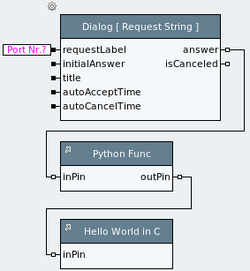HelpWizard Pages Linking Technologies3/en: Unterschied zwischen den Versionen
Zur Navigation springen
Zur Suche springen
Cg (Diskussion | Beiträge) |
Cg (Diskussion | Beiträge) |
||
| Zeile 4: | Zeile 4: | ||
[[Datei:arrowright.png|link=HelpWizard Pages Linking Technologies4/en|forward]] |
[[Datei:arrowright.png|link=HelpWizard Pages Linking Technologies4/en|forward]] |
||
Lets assume, that the input to the C-function should come from a Python function (assume that you have imported a module, which reads a value from a measurement device or your device under test). |
Lets assume, that the input to the C-function should come from a Python function (assume that you have imported a module, which reads a value from a measurement device or your device under test). Also assume, that you have already installed the required Python package(s) - typically via the "pip" installer. |
||
Create a new Python-action with input and output pins and type: |
Create a new Python-action with input and output pins and type: |
||
Version vom 19. März 2022, 07:39 Uhr
Linking Technologies: Python Actions
Lets assume, that the input to the C-function should come from a Python function (assume that you have imported a module, which reads a value from a measurement device or your device under test). Also assume, that you have already installed the required Python package(s) - typically via the "pip" installer.
Create a new Python-action with input and output pins and type:
# import <your actual modules here>
# dummy - in reality you'd call into your module...
def readFromDevice(portNr):
return "1.23456"
def execute():
port = inPin.value()
outPin.value( readFromDevice(port) )
This can now be connected to the sequence:
